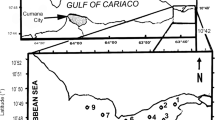Abstract
Four new xarifiid copepods are described. They were found in association with the scleractinian coral Pavona explanulata (Lamarck) occurring in shallow water reefs off Yenliao in northern Taiwan. The four species are: Xarifia capillata n. sp., X. parva n. sp., X. pavonae n. sp. and X. taiwanensis n. sp. They were found together in a single washing of the host coral. Previously, 13 species of copepods have been found in association with nine species of Pavona Lamarck. More than half (7/13) of these symbionts are members of Xarifia Humes, 1960.












Similar content being viewed by others
References
Cheng, Y.-R., Ho, J.-S., & Dai, C.-F. (2007). Two new species of Xarifia Humes, 1960 (Copepoda, Xarifiidae) associated with corals of Taiwan. Crustaceana, 80, 1135–1144.
Cheng, Y.-R., Ho, J.-S., & Dai, C.-F. (2008). Wedanus formosanus n. sp. (Poecilostomatoida, Rhynchomolgidae), a copepod parasitic in a scleractinian coral of Taiwan. Crustaceana, 81, 1099–1105.
Cheng, Y.-R., Ho, J.-S., & Dai, C.-F. (2009). Orstomella yaliuensis n. sp., a xarifiid copepod (Crustacea) parasitic in the polyps of hump coral Porites lutea Milne Edwards & Haime off Taiwan. Systematic Parasitology, 74, 17–21.
Ho, J.-S., Cheng, Y.-R., & Dai, C.-F. (2008). Six species of Xarifia (Copepod, Xarifiidae) new to Taiwan parasitic on the scleractinian corals. Journal of the Fisheries Society of Taiwan, 35, 117–136.
Ho, J.-S., Cheng, Y.-R., & Dai, C.-F. (2010). Hastatus faviae n. gen., n. sp., a xarifiid copepod parasitic in the honeycomb coral of Taiwan. Crustaceana, 83, 89–99.
Humes, A. G. (1985). Cnidarians and copepods: a success story. Transactions of the American Microscopical Society, 104, 313–320.
Humes, A. G. (1994). How many copepods? Hydrobiologia, 292/293, 1–7.
Humes, A. G., & Gooding, R. U. (1964). A method for studying the external anatomy of copepods. Crustaceana, 6, 238–240.
Kim, I. H. (2006). Copepoda (Poecilostomatoida: Anchimolgidae) associated with the scleractinian coral Gardineroseris planulata (Dana) from the Moluccas. Korean Journal of Systematic Zoology, 22, 63–78.
Veron, J. E. N. (1986). Corals of Australia and the Indo-Pacific. North Ryde, New South Wales: Angus and Robertson Publishers, 644 pp.
Acknowledgements
We are grateful to Ming-Hsien Tsai, Chi-Hsiang Chin and Shuo-Wen Chang of the National Taiwan University for their assistance in the field with the collection of coral samples. This study was partly supported by a grant from the National Science Council (NSC 98-2611-M-002 -001 -MY3) and another grant from the Fisheries Agent, Council of Agriculture, Taipei, Taiwan. Completion of this manuscript was aided by a grant from the Paramitas Foundation to J.-s.H.
Author information
Authors and Affiliations
Corresponding author
Rights and permissions
About this article
Cite this article
Cheng, YR., Ho, Js. & Dai, CF. Four new xarifiid copepods (Poecilostomatoida) associated with the scleractinian coral Pavona explanulata (Lamarck) from off Taiwan. Syst Parasitol 79, 227–240 (2011). https://doi.org/10.1007/s11230-011-9305-z
Received:
Accepted:
Published:
Issue Date:
DOI: https://doi.org/10.1007/s11230-011-9305-z




